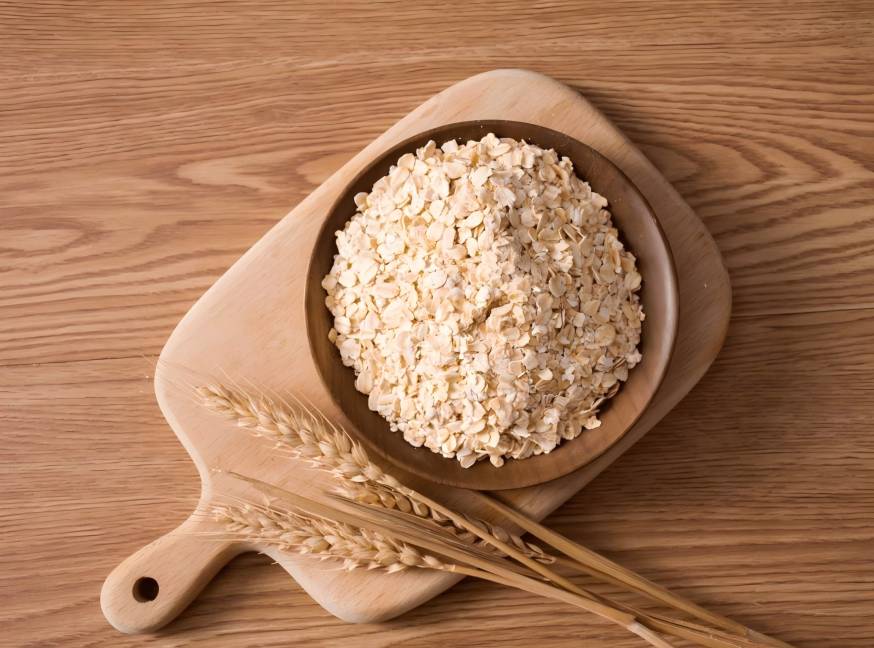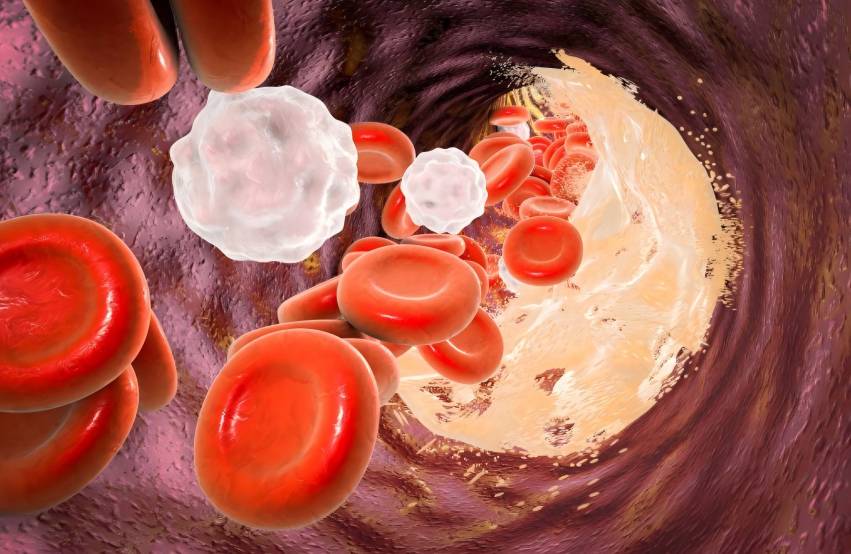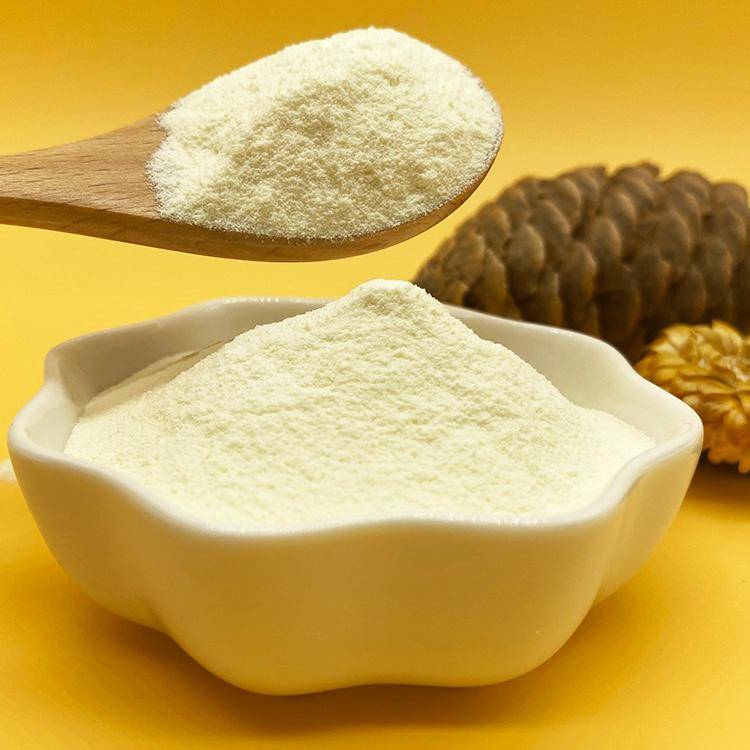What Are the Benefits of Oat Beta Glucan Powder?
Oats (Avena sativa L.) are widely cultivated and have a history of cultivation spanning more than 2,000 years around the world. Oats are a crop rich in a variety of bioactive substances and superior to many other grains (barley, corn, millet, sorghum, etc.) in terms of nutritional value [1]. Oats are usually eaten as a cereal and can provide important nutrients such as protein, unsaturated fatty acids, soluble dietary fiber, vitamins and minerals [2]. Numerous experimental and clinical studies have shown that oat-based products play a positive role in lowering serum cholesterol levels, glucose uptake, and plasma insulin response [2-5]. Oats synthesize a wide range of secondary metabolites during the maturation process, which makes oats contain a large amount of bioactive substances [6]. Oats have become an excellent source of active ingredients such as phenolic acids, flavonoids, carotenoids, vitamin E and phytosterols [6-8], and contain two unique types of bioactive substances: oat alkaloids (AVA) and steroidal saponins [9].
In addition, oats are a good source of soluble dietary fibre, especially β-glucan. β-glucan has significant physiological activities and nutritional properties, such as unique cholesterol-lowering and anti-diabetic effects. In addition, the main active ingredient in oat soluble dietary fibre is thought to be β-glucan [6]. Currently, evidence of the beneficial physiological functions of oat β-glucan has been reviewed and accepted by the US Food and Drug Administration (FDA) and the European Food Safety Authority (EFSA) [10-11]. According to existing research, oat beta-glucan can also have a positive effect on major health diseases or chronic diseases such as cardiovascular disease, type I diabetes, cancer, Alzheimer's disease, hypertension, obesity, allergies, autism, fibromyalgia and pancreatitis by interacting with the microbiota. Oat β-glucan has good water solubility, viscosity and gelling properties, and is widely used in foods such as breakfast cereals, beverages, baked goods and meat products. This article summarizes the current research on the functional properties of oat β-glucan and its application in foods.

Oat β-glucan is mainly distributed in the cell walls of the aleurone, subaleurone and endosperm tissues [6, 12-13]. Its structure is shown in Figure 1, and it is composed of pyranose glucose units linked by β-(1→3) and β-(1→4) glycosidic bonds. In oat bran, β-glucan accounts for about 4% of the dry weight and is composed of 70% β-(1→4) and 30% β-(1→3) glycosidically linked glucose units [14-16]. The basic units in the polymer chain are trimers and tetramers [17]. In oats, their molar ratio is 1 5:2.3 [9, 18].
According to nuclear magnetic resonance data and methylation analysis, the relative molecular mass of β-glucan in oats ranges from 0.35×105 to 29.6×105 [19]. Over the past 20 to 30 years, it has been recognized that the random distribution of β-(1→3) is the main reason for the functional properties of β-glucan [20-21]. The molar mass of soluble oat β-glucan is about 5×105 g/mol, while that of insoluble β-glucan is less than 2×105 g/mol [22]. Recent research has used computer technology to create a 3D model of the β-glucan molecule. In terms of its shape, the β-glucan molecule is an elongated winding chain with a spacing of 41.35 霧. The rigidity of the molecular chain increases with the ratio of trisaccharides to tetrasaccharides [23], and the oat β-glucan with a higher ratio (tetrasaccharide/trisaccharide) has a higher solution viscosity is higher [24]. Research trends indicate that the fine structure of oat β-glucan will be one of the key research areas in the future.
1 β-glucan structure and functional properties
1.1 Structure and physical properties
Studies have shown that the physiological functions of β-glucan mainly depend on its water solubility and viscoelastic properties. At low concentrations of β-glucan, its viscosity is relatively high. When the mass concentration is higher than 2 g/L, its viscosity decreases with increasing shear rate, showing pseudoplasticity [26]. β-Glucan also has high water retention capacity and gelation properties. When β-glucan is dissolved in water, it can form a viscous solution. Its special rheological properties are closely related to its physiological properties [27]. Shen Ruiling et al. [28] compared the rheological properties of two molecular weight oat β-glucans, and the results showed that oat β-glucan solution is a non-Newtonian fluid. When the mass fraction of the solution is in the range of 0.2% to 3%, the viscosity decreases with increasing shear rate.
Wang et al. [29] reported that the viscosity of oat β-glucan solution decreases with increasing shear rate, a typical non-Newtonian fluid. Johansson et al. [30] showed that oat β-glucan has a higher viscosity than barley β-glucan at the same concentration, indicating that the two have different fine structures. Studies [31-32] have shown that at the same tri- and tetraoxy- group content, the viscosity of oat β-glucan at the same concentration is 100 times that of barley β-glucan, which may be due to differences in structural properties (molar mass) and differences in fine structure. In summary, oat β-glucan solutions are non-Newtonian fluids, and their concentration, molecular mass and temperature all have an effect on them. Due to differences in structural properties, oat β-glucan has a higher viscosity than other cereal β-glucans, but the reasons for this are still debated. Therefore, the influence of the fine structure of oat β-glucan on its viscoelastic and functional properties will be one of the focuses of future research.
1.2 Nutritional properties
Oat β-glucan plays an important role in promoting health and preventing disease. It has a positive effect on the normalization of intestinal flora, the prevention of diabetes, the reduction of cholesterol and blood pressure, the control of postprandial blood sugar and insulin response, the reduction of the risk of cardiovascular disease and the regulation of appetite, and can alleviate the complications of diabetes [33-37]. Oat β-glucan can increase postprandial satiety [38-39], which may be due to the indigestible nature of β-glucan in the gastrointestinal tract. In addition, studies have also shown that oat β-glucan plays an important role in reducing abdominal fat and obesity, mainly in terms of reducing body weight, body mass index, body fat and waist-to-hip ratio [40]. Recent studies have shown that consumption of oat beta-glucan products can enhance endurance and recovery from fatigue in rats [41].
1.2.1 Beneficial for stomach and intestinal health
In the past 10 years, research on the intestinal and gastric microbiota has reached new heights, attracting widespread attention from food science researchers. The microbial community in the body can help the host resist various external adverse factors and provide important protection. Clinical trials have confirmed that the bacterial flora in the stomach and intestines can cure various pathological conditions [42-43]. Changes in the microbial community have a significant impact on the physiology and function of the host, and β-glucan, as an important component of prebiotics, can have a positive impact on the microbial community in the stomach and intestines [44].
Brennan et al. [45] reported that oat beta-glucan can form a gel-like network in the human body, changing the viscosity of gastric and intestinal fluids. In addition, oat beta-glucan also has a positive effect on the intestines and stomach. For example, it cannot be digested by digestive enzymes (salivary amylase, etc.) and can effectively inhibit the growth of mucosa-feeding bacteria in the intestines and stomach. Oat β-glucan can also protect the liver by improving the growth conditions of beneficial bacteria (such as lactobacilli and bifidobacteria), increasing the number of microorganisms. In the large intestine, oat β-glucan is fermented by microorganisms, especially by lactobacilli and bifidobacteria in the cecum, to produce bifidobacteria, which are beneficial to human health. Shimotoyodome et al. [46] and Hedemann et al. [47] showed that oat beta-glucan can promote the growth of the colon mucosa in rats and play an important role in the intestine.
Metzler-Zebeli et al. [48] showed in a trial with weaned pigs that oat beta-glucan can alter the expression of some genes by increasing the production of short-chain fatty acids. Therefore, oat beta-glucan can be used as a prebiotic to promote human health. O'SHEA et al. [49] found that the mixed-linked β-(1→3)/β-(1→4) ) β-glucans may be a fermentation substrate for symbiotic bacteria, and consumption of oat β-glucans may stimulate the growth of more symbiotic stomach and intestinal microbiota. Oat β-glucan also increases insulin sensitivity. Consumption of whole oat flour or oat β-glucan can increase intestinal Na+K+-ATP and Ca2+Mg2+-ATP enzyme activity and energy charge, especially in the ileum [50-51]. However, the mechanism by which oat β-glucan affects the interaction between the stomach and the intestinal microflora is unclear and deserves further research.

1.2.2 Anti-diabetes
Diabetes is generally characterized by hyperglycemia, with polyuria, polydipsia, and weight loss as typical symptoms [52]. Current research shows that oat beta-glucan can lower cholesterol and triglycerides and maintain stable blood glucose levels. Therefore, research on the use of oat beta-glucan to control diabetes is extensive. Tappy et al. [53] showed through clinical trials that the hypoglycemic effect of oats and oat bran is mainly due to oat beta-glucan. Abbasi et al. [54] confirmed that oat beta-glucan can postprandial blood glucose concentrations and can regulate the activity of intestinal glucose transport proteins, providing an effective way to lower blood glucose levels in diabetic patients.
Birklund et al. [55] found that a beverage rich in β-glucan had a positive effect on glucose and insulin levels. Consuming 5 g of oat β-glucan can improve insulin levels and maintain stable glucose levels. Hooda et al. [56] found that adding 6% oat β-glucan concentrate to the diet can significantly reduce glucose levels in pigs, and increased levels of short-chain fatty acids and insulin, changes that were associated with gastric inhibitory peptide and GLP-1. Alminger et al. [57] studied changes in the microbial flora and found an increase in the Firmicutes/Bacteroidetes ratio. In vitro studies have shown that oat supplementation can increase the number of Bacteroides species. After β-glucan is digested by the microbiota, it increases the production of propionate and butyrate production, and oat β-glucan-enriched products can more effectively reduce glucose and insulin responses compared to low-dietary-fiber products.
Shen et al. [58] fed diabetic mice with oat β-glucan for 6 weeks and found that oat β-glucan significantly reduced fasting blood glucose and glycosylated serum protein levels, increased glycogen levels, reduced free fatty acids and inhibited pancreatic apoptosis. Rumberger et al. [59] found that oat β-glucan produced more butyrate than other fibres, suggesting that oat β-glucan can be used as a potential drug for the treatment of diabetes. Wang et al. [60] found that a higher viscosity β-glucan solution has a better ability to lower blood sugar. Studies have also shown that consuming foods rich in oat β-glucan can lower blood sugar levels in the body, especially in diabetics [61-62], which may be due to β-glucan's ability to increase the viscosity of chyme, thereby delaying the intestinal absorption of glucose. Turnbaugh et al. [63] found that oat β-glucan had a positive effect on obese mice by increasing the microbiota genes encoding dietary polysaccharide-degrading enzymes in obese mice. In summary, the mechanism of action of oat β-glucan on the genes encoding dietary fiber polysaccharide-degrading enzymes is one of the focuses of future research on the anti-diabetic mechanism of oat β-glucan.
1.2.3 Lowering cholesterol
Oat β-glucan is well known for its cholesterol-lowering effect. The US Food and Drug Administration (FDA) and the European Food Safety Authority (EFSA) have shown that 3 g of oat or barley β-glucan per day is beneficial for lowering blood cholesterol levels and reducing the risk of coronary heart disease [64]. Whitehead et al. [65] showed that a daily intake of at least 3 g of oat β-glucan can reduce total plasma cholesterol and low-density lipoprotein cholesterol levels by 5% to 10% in normal or high cholesterol patients reduce plasma total cholesterol and low-density lipoprotein cholesterol levels by 5% to 10%. A dose greater than 3 g/d can reduce total blood and low-density lipoprotein cholesterol levels by 0.25 mmol/L and 0.30 mmol/L, respectively, without changing high-density lipoprotein cholesterol or triglycerides.
An analysis by Ho et al. [66] showed that oat beta-glucan has a lowering effect on LDL-cholesterol and non-HDL-cholesterol. Therefore, foods rich in beta-glucan may have the potential to reduce the risk of cardiovascular disease. Wolever et al. [67] observed that the physical and chemical properties of oat beta-glucan at the molecular scale have a positive effect on blood cholesterol levels, especially in relation to the weight average molecular mass, solubility and viscosity. The current mechanism by which oat beta-glucan lowers blood cholesterol is not yet clear, and the ability of oat beta-glucan to interfere with bile salt recycling and the mechanism of its effect on cholesterol metabolism are currently the more authoritative results [68-70].

Theuwissen et al. [71] showed that the main mechanism by which oat β-glucan reduces cholesterol through the intestinal microbiota is to produce short-chain fatty acids (propionate). The intestinal microbiota metabolizes fiber and produces short-chain fatty acids for the host, and an increase in the ratio of propionate to acetate (the main substrate for cholesterol biosynthesis) leads to a decrease in cholesterol biosynthesis. There have been many studies on oat β-glucan lowering cholesterol, but the mechanism of its ability to interfere with the bile salt cycle is still unclear. It is also unclear whether the physicochemical properties of oat β-glucan, such as particle size, solubility, and conformation, can also affect cholesterol metabolism. This is also one of the important research directions in the future.
1.2.4 Immune effects
Studies have shown that polysaccharides can enhance immunity, which provides a broad field for the research of new safe and tolerable immune adjuvants. Among the polysaccharides studied, β-glucan has the greatest potential for application [72]. Oat β-glucan is considered a strong immunostimulant that can bind to surface receptors on immune cells (monocytes, granulocytes and NK cells), activate and regulate humoral and cellular immunity, and thus stimulate the immune response. Oat β-glucan may work through three immunostimulatory mechanisms, regulating the activity of macrophages, T lymphocytes and the complement system. Due to these properties, oat β-glucan can regulate the natural immune response and enhance the adaptive immune response by stimulating the activity of T lymphocytes [73-74].
Studies in animal models have shown that the addition of oat beta-glucan to the diet can activate T cells that express the CD8 and TCR1 surface molecules, thereby enhancing the immune system [75]. Jin et al. [76] found that oat beta-glucan can modulate the immune response when used alone, and can connect natural immunity and adaptive immunity to improve the immunogenicity of vaccines. When oat beta-glucan is used as an immune stimulant or immune adjuvant, , deamidase, CR3, CD5, and endoplasmic reticulum-associated neurophilin can recognize oat β-glucan receptors. Yun et al. [77] found that β-glucan can effectively change the number of cells in the mesenteric lymph nodes and Peyer's patch lymph nodes of mice (Thy1.2, CD4 and CD8 cells). Oral or parenteral administration of oat β-glucan can enhance the resistance of mice to infection with Staphylococcus aureus or pests. Oral or parenteral treatment with oat β-glucan oat β-glucan to enhance the resistance of mice to infection with Staphylococcus aureus or Escherichia coli.
Udayangani et al. [78] also found that β-glucan has immunomodulatory properties, and the survival rate of zebrafish (zebrafish attacked by pathogenic bacteria) administered with nano-β-glucan was significantly increased. Sa-hasrabudhe et al. [79] showed that enzymatic pre-digestion of oat β-glucan enhanced its effect on specific immune receptors. Effective functional feed and food additives can be designed by controlling the particle size and molecular weight of oat β-glucan as well as the receptor-specific binding sites. Rusch et al. [80] showed that the molecular specificity of oat β-glucan plays an important role in immunomodulation. For example, the characteristics of oat β-glucan insolubility, particle size, particle conformation and particle uniformity characteristics. It can be seen that the site of receptor-specific binding of oat β-glucan will be one of the key research areas in the future direction of the immunological effects of oat β-glucan.
1.2.5 Anti-cancer
Recent studies have found that many herbs rich in complex polysaccharides have good anti-cancer effects. These complex polysaccharides are, for example, β-glucan, a non-cellulose polymer with glycosidic linkages at the β-(1-3), β-(1-4) or β-(1-6) positions [81]. The anti-cancer effects of β-glucan have been shown to be related to the complexity of its structure. Some results indicate that the immunomodulatory and anti-cancer functions of β -glucan's immunomodulatory and anticancer functions are closely related to its structure, molecular weight, branching degree and conformation [36, 82]. There is currently no clear evidence that β-glucan can be effectively used as an anticancer factor. However, many studies have explained its effects on cancer cells in vitro and in vivo [83-85]. Choromanska et al. [86] tested three cell lines (human lung adenocarcinoma, human multidrug-resistant small cell lung cancer, and normal human keratinocytes) and found that oat β-glucan has strong antitumor properties, while being non-toxic to normal cells.
Cheung et al. [84] and Demir et al. [87] found that oat β-glucan plays an important role in the immune activation process of killing cancer cells. In addition, studies have shown that oat beta-glucan has a positive effect on the health of rats with colitis induced by LPS injection [88-91]. Blaszczyk et al. [92] concluded from changes in gene expression that oat beta-glucan exerts a protective effect in rats with inflammation induced by LPS, and pointed out that the mode of action of high molecular weight and low molecular weight beta-glucans in vivo is different. The molecular mass of oat β-glucan determines its effect in vivo [93]. Studies have shown that high-molecular-weight oat β-glucan is more effective in reducing LPS-induced oxidative stress in colonic tissue and in the stomach, liver or spleen [88-91], while dietary supplementation with low-molecular-weight oat β-glucan improves the morphology of colonic tissue in healthy control rats and in animals with LPS-induced colitis [88]. The influence of the physical characteristics of oat β-glucan on the immunological activation of cancer cells will be one of the focuses of future research on the functional properties of oat β-glucan.
2 Food applications
Beta-glucan has various functions such as thickening, stabilizing, emulsifying and gelling [94]. In recent years, oat beta-glucan has attracted much attention in the field of food research, as it has been found that obese people have a higher risk of coronary heart disease, hypertension, stroke, diabetes and cancer due to excessive fat intake, and functional foods are a safe way to treat various diseases. Oat β-glucan is mainly used for its emulsifying, thickening, stabilizing and gelling properties in the preparation of functional foods such as meat, bakery products, sauces, soups, beverages and other foods [25]. The following details the application of oat β-glucan in several food industries.
2.1 Meat products
With people's growing awareness of healthy eating, the functional food market has been growing since its inception in the mid-1980s. One way to develop functional foods is to use ingredients such as prebiotics. Prebiotic substances can enhance the activity of beneficial bacteria in the intestine, and there is increasing scientific evidence that oat β-glucan and microbial exopolysaccharides have a positive effect on human health [35].
Wollowski et al. [95] showed that a high-meat diet increases the risk of colon cancer, while prebiotics and probiotics have anticancer effects, which can be achieved by reducing DNA damage in colon cells, reducing the activity of procarcinogenic enzymes, inhibiting the binding of mutagens, and increasing immune stimulation. Amini et al. [96] showed that oat beta-glucan had a significant effect on the physical and sensory properties of sausages, and Oat β-glucan and resistant starch can be used in combination to produce probiotic sausages. Afshari et al. [97] added β-glucan to hamburger patties, which improved their cooking rate, moisture retention rate and acceptability, as well as their mouldability. Oat β-glucan can be added to various meat products as a prebiotic ingredient to improve their quality and enrich meat-based functional foods.

2.2 Baked goods
Adding oat β-glucan to the preparation of bread and cakes can improve the physical and chemical properties of the bread. Adding oat β-glucan to pasta-based foods can lower the glycemic index and effectively combat metabolic diseases [98]. Bread and cakes containing oat β-glucan can delay the release of glucose and prevent hyperglycemia. Ek-ström et al. [99] found that oat β-glucan is suitable for baking because of its high molecular weight and can be used to adjust the glycemic profile of bread products. Compared with barley β-glucan, oat β-glucan has better rheological properties and can produce higher-quality bread. This may be due to the higher viscosity of the high molecular weight oat β-glucan [100]. Therefore, oat β-glucan can be added to baked goods to improve their quality and enrich functional baked goods.

2.3 Beverage industry
Oat β-glucan can be used not only in cereal foods, but also in low-fat ice cream, yogurt, beverages and other foods [101]. Some studies have shown that the addition of oat β-glucan can promote the growth and vitality of lactobacillus in yogurt [102]. Rezaei et al. [103] showed that the addition of oat β-glucan to frozen yogurt can increase the viscosity, expansion, hardness and stability of yogurt, and prolong the aging time at low temperatures, which can adjust the texture characteristics of frozen soy yogurt and thus improve the quality of this frozen dessert. L adjevardi et al. [104] improved the viability of probiotics, reduced the fat content of yogurt and improved the quality of yogurt by adding oat β-glucan.
Mahrous et al. [105] showed that the addition of oat beta-glucan had no significant effect on the chemical composition of stirred and concentrated yogurts. Sharafbafi et al. [106] added high molecular weight oat beta-glucan to milk to prepare a dairy product with low calories and low cholesterol content. Rinaldi et al. [107] found that yogurt containing β-glucan and pectin had a faster rate of protein breakdown, faster release of peptides and a higher proportion of free amino acids than yogurt containing starch and no β-glucan. Lyly et al. [108] and Mielby et al. [109] found that the addition of oat β-glucan reduced the saltiness and clarity of tomato soup and the acidity of fruit drinks, while there was no significant effect on the perception of the aftertaste of the drinks. Brennan et al. [110] believe that the addition of oat β-glucan can also be used to control the glycemic response of puffed snack products. Therefore, oat β-glucan has broad application prospects in the beverage industry.

3 Conclusions and prospects
Oat β-glucan, as a soluble dietary fiber, has a wealth of functional properties and can be widely used in functional foods and the biomedical field. This paper reviews the development and utilization of oat β-glucan resources, with a view to further expanding the application value of oat β-glucan. Current research focuses on the improvement of the gastrointestinal digestion properties of oat β-glucan. Although it has been clearly established that β-glucan has a significant effect on the microbiome and plays a positive role in intestinal health, the exact mechanism of action and the target of oat β-glucan on the microbiome are still unclear and warrant further research.
In addition, current research mainly focuses on oat β-glucan as a single ingredient, while it is also important to investigate whether ingredients rich in oat β-glucan and oat β-glucan-ligand complexes also have similar properties to oat β-glucan and how their mechanisms of action work. Finally, a systematic study of the relationship between the molecular structure (such as molecular weight, unit composition and particle size) and the physical and chemical properties and functional characteristics of oat β-glucan is needed, especially the molecular mechanisms of immune system enhancement and anticancer effects, so that oat β-glucan can better serve mankind.
Reference:
[1] LOSKUTOV I , POLONSKIY V. Content of beta - glucans in oat grain as a perspective direction of breeding for health products and fodder[J]. Agricul- tural Biology ,2017 ,52(4): 646-657.
[2] SHEWRY P R ,PIIRONEN V ,LAMPI A M ,et al. Phytochemical and fiber components in oat varieties in the HEALTHGRAIN diversity screen[J]. Journal of Agricultural and Food Chemistry , 2008 , 56(21): 9777-9784.
[3] WEBSTER F ,WOOD P. Oats: chemistry and tech- nology[M]. Saint Paul ,MN :Academic Press ,2016.
[4] KENDALL C W , ESFAHANI A , JENKINS D J. The link between dietary fiber and human health[J]. Food Hydrocolloids ,2010 ,24(1): 42-48.
[5] BALLABIO C , UBERTI F , MANFERDELLI S , et al. Molecular characterisation of 36 oat varieties and in vitro assessment of their suitability for coeliacs' diet [J]. Journal of Cereal Science , 2011 , 54(1): 110-115.
[6] FINCHER G , STONE B. Cell walls and their components in cereal grain technology[ J ] . Advances in Cereal Science and Technology , 1986 ,8 :207-295.
[7] MAZZA G. Functional foods: biochemical and pro cessing aspects[M]. Lancaster,PA:CRC Press ,1998.
[8] WOOD P J. Physicochemical properties and physiological effects of the(1→3)(1→4)-β-D-glucan from oats[M]// FURDA I , BRINE C J. New developments in dietary fiber :physiological ,physicochemical ,and analytical aspects: Boston , MA: Springer US, 1990: 119-127.
[9] MILLER S ,FULCHER R.Oat endosperm cell walls :II. Hot-water solubilization and enzymatic di- gestion of the wall [J]. Cereal Chemistry , 1995, 72(5): 428-432.
[10] FOOD U ,ADMINISTRATION D. FDA final rule for federal labeling: health claims: oats and coronary heart disease[J]. Fed Regist , 1997 , 62(15): 3584- 3601.
[11] EFSA Panel on Dietetic Products , Nutrition Aller- gies. Scientific Opinion on the substantiation of health claims related to beta glucans and mainte- nance of normal blood cholesterol concentrations(ID 754 , 755 , 757 , 801 , 1465 , 2934) and maintenance or achievement of a normal body weight(ID 820 , 823) pursuant to Article 13(1) of Regulation (EC) No 1924/2006 [J]. EFSA Journal , 2009 , 7(10): 1-18.
[12] BACIC A ,STONE B. A(1→3)-and(1→4)-linked β -d -glucan in the endosperm cell -walls of wheat [J]. Carbohydrate Research , 1980 ,82(2): 372-377.
[13] SAULNIER L , PENEAU N , THIBAULT J F. Vari- ability in grain extract viscosity and water -soluble arabinoxylan content in wheat[ J ] . Journal of Cereal Science , 1995 ,22(3): 259-264.
[14] XU R. Oat fiber: overview on their main biological properties[J]. European Food Research and Technolo- gy ,2012 ,234(4): 563-569.
[15] Chen Jiliang, Lu Xiaowen, Lv Feijie, et al. Research progress on barley β-glucan [J]. Food Science and Technology, 2006, 31(4): 12-14.
[16] LIANGLI L Y ,TSAO R , SHAHIDI F. Cereals and pulses: nutraceutical properties and health benefits [M]. Chichester ,UK :John Wiley & Sons ,2012.
[17] WOOD P J. Physicochemical characteristics and physiological properties of oat(1→3),(1→4)-β-D- glucan[M]// WOOD P J. Oat bran: Saint Paul ,MN: AACC International Press , 1993: 83-112.
[18] SKENDI A , BILIADERIS C , LAZARIDOU A , et al. Structure and rheological properties of water sol- uble β -glucans from oat cultivars of Avena sativa and Avena bysantina [J]. Journal of Cereal Science, 2003 ,38(1): 15-31.
[19] YAO N , JANNINK J L , WHITE P J. Molecular weight distribution of(1→3)(1→4)-β - glucan af- fects pasting properties of flour from oat lines with high and typical amounts of β - glucan [J] . Cereal Chemistry ,2007 ,84(5): 471-479.
[20] IZYDORCZYK M , DEXTER J. Barley β -glucans and arabinoxylans: Molecular structure , physico- chemical properties , and uses in food products -a review [J]. Food Research International , 2008 , 41
(9): 850-868.
[21] WOOD P J. Oat and rye β - glucan: properties and function [J]. Cereal Chemistry , 2010 , 87(4): 315 - 330.
[22] JOHANSSON L , TUOMAINEN P , YLINEN M , et al. Structural analysis of water-soluble and-insoluble β-glucans of whole-grain oats and barley[J]. Carbo- hydrate Polymers ,2004 ,58(3): 267-274.
[23] LI W , CUI S W , WANG Q , et al. Study of con- formational properties of cereal β -glucans by com- puter modeling [J]. Food Hydrocolloids , 2012 , 26
(2): 377-382.
[24] RYU J , LEE S , YOU S , et al. Effects of barley and oat β-glucan structures on their rheological and thermal characteristics [ J ] . Carbohydrate Polymers , 2012 ,89(4): 1238-1243.
[25] ZHU F , DU B , XU B. A critical review on pro- duction and industrial applications of beta-glucans[J]. Food Hydrocolloids ,2016 ,52 :275-288.
[26] DONGOWSKI G , DRZIKOVA B , SENGE B , et al. Rheological behavior of β -glucan preparations from oat products [J] . Food Chemistry , 2005 , 93(2): 279-291.
[27] HU X , ZHAO J , ZHAO Q , et al. Structure and characteristic of β - glucan in cereal: a review [J]. Journal of Food Processing and Preservation , 2015, 39(6): 3145-3153.
[28] Shen Ruiling, Yao Huiyuan. Rheological properties and gel formation of beta-glucan from naked oat bran [J]. Journal of Wuxi University of Light Industry (Food and Biotechnology), 2005 (1): 41-44.
[29] WANG H ,XU Q ,LIU D ,et al. Rheological prop- erties of β-glucans from oats[J]. Transactions of the Chinese Society of Agricultural Engineering , 2008, 5 :45-50.
[30] JOHANSSON L,KARESOJA M,EKHOLM P, et al. Comparison of the solution properties of(1→3),(1→4)-β-d-glucans extracted from oats and barley [J]. LWT -Food Science and Technology,2008,41(1): 180-184.
[31] PAPAGEORGIOU M ,LAKHDARA N ,LAZARIDOU A ,et al. Water extractable(1→3 , 1→4)-β-D-glu- cans from barley and oats :An intervarietal study on their structural features and rheological behavior [J]. Journal of Cereal Science ,2005 ,42(2): 213-224.
[32] MIKKELSEN M S , JESPERSEN B M , MLLER B L , et al. Comparative spectroscopic and rheological studies on crude and purified soluble barley and oat β-glucan preparations[J]. Food Research Internation- al ,2010 ,43(10): 2417-2424.
[33] PINS J ,KAUR H. A review of the effects of barley β-glucan on cardiovascular and diabetic risk[J]. Ce- real Foods World ,2006 ,51(1): 8-11.
[34] ALEIXANDRE A , MIGUEL M. Dietary fiber in the prevention and treatment of metabolic syndrome: a review[J]. Critical Reviews in Food Science and Nu- trition ,2008 ,48(10): 905-912.
[35] KHOURY D E , CUDA C , LUHOVYY B L , et al. Beta glucan :health benefits in obesity and metabol- ic syndrome[J]. Journal of Nutrition and Metabolism, 2011 ,2012(2): 1-28.
[36] DAOU C ,ZHANG H. Oat beta - glucan :its role in health promotion and prevention of diseases[J]. Com- prehensive Reviews in Food Science and Food Safe- ty ,2012 , 11(4): 355-365.
[37] DU B , BIAN Z , XU B. Skin health promotion ef- fects of natural beta - glucan derived from cereals and microorganisms: a review [J]. Phytotherapy Re- search ,2014 ,28(2): 159-166.
[38] BECK E J ,TOSH S M ,BATTERHAM M J ,et al. Oat β - glucan increases postprandial cholecystokinin levels,decreases insulin response and extends sub- jective satiety in overweight subjects [J]. Molecular Nutrition & Food Research , 2009 , 53(10): 1343- 1351.
[39] PENTIKINEN S , KARHUNEN L , FLANDER L, et al. Enrichment of biscuits and juice with oat β - glucan enhances postprandial satiety [ J ] . Appetite , 2014 ,75: 150-156.
[40] CHANG H C , HUANG C N , YEH D M , et al. Oat prevents obesity and abdominal fat distribution, and improves liver function in humans[J]. Plant Foods for Human Nutrition ,2013 ,68(1): 18-23.
[41] XU C , LV J , LO Y M , et al. Effects of oat β - glucan on endurance exercise and its anti -fatigue properties in trained rats[J]. Carbohydrate Polymers, 2013 ,92(2): 1159-1165.
[42] NEIS E , DEJONG C , RENSEN S. The role of mi- crobial amino acid metabolism in host metabolism[J]. Nutrients ,2015 ,7(4): 2930-2946.
[43] JAYACHANDRAN M , CHEN J , CHUNG S S M, et al. A critical review on the impacts of β-glucans on gut microbiota and human health[J]. The Journal of Nutritional Biochemistry ,2018 ,61: 101-110.
[44] SLAVIN J. Fiber and prebiotics: mechanisms and health benefits [J] . Nutrients , 2013 , 5(4): 1417 - 1435.
[45] BRENNAN C S ,CLEARY L J. The potential use of cereal (1 →3 , 1 →4)-β -D -glucans as functional food ingredients[J]. Journal of Cereal Science ,2005, 42(1): 1-13.
[46] SHIMOTOYODOME A , MEGURO S , HASE T , et al. Short chain fatty acids but not lactate or succi- nate stimulate mucus release in the rat colon [J]. Comparative Biochemistry and Physiology Part A: Molecular & Integrative Physiology , 2000 , 125(4): 525-531.
[47] HEDEMANN M S , THEIL P K , KNUDSEN K B. The thickness of the intestinal mucous layer in the colon of rats fed various sources of non -digestible carbohydrates is positively correlated with the pool of SCFA but negatively correlated with the propor- tion of butyric acid in digesta [J]. British Journal of Nutrition ,2009 , 102(1): 117-125.
[48] METZLER-ZEBELI B U , GNZLE M G,MOSEN- THIN R , et al. Oat β -glucan and dietary calcium and phosphorus differentially modify intestinal ex- pression of proinflammatory cytokines and monocar- boxylate transporter1and cecal morphology in weaned pigs[J]. The Journal of Nutrition ,2012 , 142(4): 668-674.
[49] O'SHEA C , SWEENEY T , LYNCH M , et al. The effect of introducing purified β-glucans to a wheat- based diet on total tract digestibility and gaseous manure emissions from pigs as compared with con


 English
English French
French Spanish
Spanish Russian
Russian Korean
Korean Japanese
Japanese




